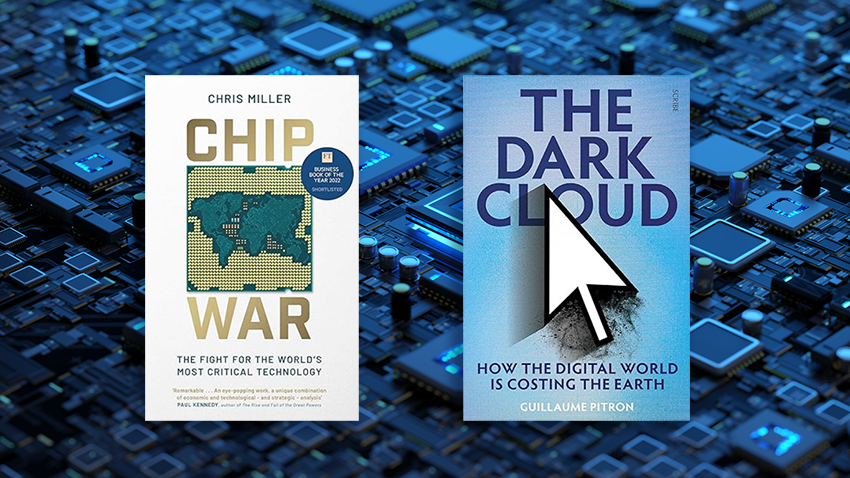Review: Chip War by Chris Miller & The Dark Cloud, Guillaume Pitron
Apart from the internal combustion engine, the silicon chip is the invention that has most changed the modern world. We may forget how astonishing this invention is: chips contain millions or billions of transistors – tiny on and off switches that store the 0s and 1s that are the basis for all of the information stored on every computer. Software from Silicon Valley may have made some rich beyond imagining, but this wealth would not exist without chips. With their ubiquity and importance to communications, transport, business and the military, their manufacture is also the centre of a global power struggle.
Chips are the result of a complicated global supply chain – designed in the US with blueprints from the UK, made in Asia or the US on machines from Japan or Holland, and controlled by a handful of companies. Events like lockdowns restrict the chain. China still relies on these global chains but is spending billions in an effort to make their own supply chains and not rely on the US, Europe or their neighbours.
Chris Miller’s detailed and geopolitically attuned book tells how workers at Bell Labs in the US in the 1940s came up with the chip, after the limitations of tube computing became obvious. Jack Kilby is credited with the chip’s invention and won the Nobel Prize. (William Shockley won for his invention of the transistor.) A breakaway group formed the Fairchild Semiconductor company, an early iteration of what would become the Silicon Valley phenomenon, partly because they could see the money-making potential of chips.
Chips are called ‘chips’ because they are ‘chipped off’ a silicon wafer. Fiddly to produce, they need the most complicated machines on Earth, with the exception of the likes of the hadron collider. Current manufacture, using lasers and mirrors, is so precise it sounds like science fiction. Chips abide by Moore’s Law (Moore was a worker at Fairchild) which describes correlations of miniaturisation and lower costs. Miniaturisation led to consumers using chips, rather than just the military. Mass production, though, is a legacy of the Cold War, and the dark history of the chip is that we might not have them if not for US expenditure on weapons.
The program of building up Japan during the Cold War led to chips being incorporated into consumer electronics – first it was Sony, then the likes of Sharp with their pocket calculators. In the 1980s Japan led with the making of not just consumer goods, but also chips, but in the 1990s Japan faltered, missing the sudden rise of PCs, where Intel excelled. The supply chain was utilised by South Korea to boost its economy; it inserted itself into the chain by building what others designed. In the 1960s, Taiwan saw Korea’s success and replicated it; chips were a way for Taiwan to gain US protection, and chip manufacturer TSMC is a world leader. Although assembled in China, an iPhone’s chips are made in Taiwan.
China is completely dependent on foreign chips, including for its AI and surveillance. It didn’t get in early because of Mao’s prejudices; now the Chinese want to extricate themselves from the global supply chain for supposed security (read: censorship) reasons, with Xi proclaiming they will build their own chip industry, a hideously complicated and expensive business. Here, the lure of profits may bite the US. IBM is heavily involved in US security, but it is also selling expertise to the Chinese.
The Chinese have said that, ultimately, their security would involve controlling TSMC, but they also know that destroying Taiwanese chip factories in a conflict would not help China. Chip manufacture is therefore a not insignificant part of the delicate and dangerous manoeuvring in the Taiwan Strait.
It’s not just the chip that creates our virtual world. It is embedded in a system of manufacture and use that is environmentally hazardous, according to Guillaume Pitron, who writes that ‘digital is very physical.’ ‘Green IT’ is often mentioned in terms of electrical, and therefore carbon, savings but talk of green IT often excludes factors like e-waste. Like where our water and food come from, modern citizens don’t always know the environmental cost of our virtual society. It’s an irony that young people are the most environmentally aware but also the biggest users of resource-sucking IT.
In the early days of personal computing, it was thought it would be an environmental boon, lessening paper use. But the manufacture of chips makes an insane amount of waste. Half of the carbon footprint in phones is in their manufacture. Most batteries in phones come from China, where graphite mining pollutes miners and countryside. We are using larger and larger amounts of precious metals, often with names you’ve never heard of. Twenty-five percent of the world’s silver now goes into IT hardware.
The idea of the ‘cloud’ gives the impression of a cute, ethereal, magical land of cost-free computing, but we are ‘drowning in a sea of data’, and this data is stored on servers that take resources to build and house in ever larger and more numerous data centres that use more and more power. It is thought that about 10 percent of our global electricity is used to power all those cat videos (and the rest) on the internet. This is double the carbon footprint of the airline industry. In Paris, Amazon’s data centres now use, supposedly, about a third of the city’s power.
The price of continuity of the ever-expanding internet, now encompassing the so-called ‘internet of things’ (fridges, watches, air conditioners, cars, scooters) is massive infrastructure and high resource use. We are told new technologies will be more efficient, but that just means more data use, not less electricity use (what is called the ‘rebound effect’). As well as this, built-in obsolescence means ever-growing piles of junked obsolete hardware.
Some are countering this with volunteer repair centres, to encourage repair and re-use rather than repurchase. Some are advocating for partial de-virtualising, and prioritisation of internet usage. A site such as Wikipedia has much lower power use, despite its size, because it is largely text based. Interestingly, the more private your interactions with websites, the less data is shared and less power used. You can reduce electricity use by cleaning up old, redundant data (like old emails) off the cloud. Of course, reducing your internet use is good (for many reasons). You can watch fewer cat videos. And read a book instead.
Nick Mattiske blogs on books at coburgreviewofbooks.wordpress.com and is the illustrator of Thoughts That Feel So Big.












